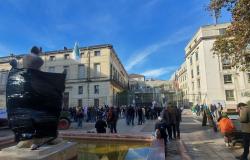
A study carried out for the community of communes of Saint-Affrique draws the outlines of a possible recovery with conditions.
Adiv (Analysis of decisions and investments) is an agro-industrial technical institute based in Clermont-Ferrand. He was commissioned by the community of municipalities to carry out a study on the possible future of the slaughterhouse which belongs to the community. Alain Peyron, the general director of Adiv, recently presented the conclusions to elected officials during the community council. In total, twenty-five players in the sector were interviewed, including former directors and employees of the slaughterhouse, but also breeders, state services and the judicial liquidator.
Succession of operating difficulties
The Saint-Affrique slaughterhouse has experienced a succession of operating difficulties in recent years which have led to administrative and legal proceedings. Relaunched in October 2023 by SAS Abattoir Sud-Aveyron Saint-Affrique, the tool once again had its health approval withdrawn last March.
Liquidated in June after three bankruptcy filings
In June, the Rodez commercial court recorded the judicial liquidation of the SAS which had been in receivership proceedings since the end of May. The tool is now closed and the thirty-three employees are made redundant. Since 2014, the slaughterhouse has experienced three bankruptcy filings. Only the period 2014-2018, with Jacques Poujol at its head, was in surplus with a slaughter volume around 6,000 to 6,500 tonnes of carcass equivalent (Tec) per year composed of a majority of large cattle.
“This shows the difficulties of operating a multi-species slaughterhouse which, to break even, must slaughter enough cattle with service prices that cover all costs” underlines the Adiv report. Today, it is Christine Dauverchain, judicial administrator in Montpellier, who is in charge of the liquidation. According to the study and the administrator's statements, “the asset price displayed for the takeover of the SAS is €2.2 million. Takeover proposals were made for €150 thousand, proposals refused.”
Auctions for equipment?
Maître Dauverchain plans, in agreement with the Commissioner of Justice, to sell the equipment at auction with a price of €800,000. “She plans to terminate the long lease early,” declares Alain Peyron. “The time frame for the operation is four or five months. You have to be careful because after that it's the sale of scrap metal. The action to be taken is to share this study with all the stakeholders interviewed.”
As a pre-conclusion of the study, “the tool remains an interesting opportunity because it is generally in good general condition. Even if investments are necessary to repair defective equipment or conveying (around 1 M€ to 1, 5 M€), they are out of proportion with the construction of a new multi-species slaughterhouse costing 3,500 Tec per year, currently estimated at 8 M€. This tool has an operational cutting workshop with the possibility of arrange a processing workshop (big asset) A cutting workshop of this type would cost around €2.8 million today.”
Concerning the position of Maître Dauverchain, “the community of communes has launched legal action to claim,” declares Sébastien David, president of the community of communes. “Because the Slimani family (Editor's note; SAS Abattoir Sud-Aveyron) tells the administrator that it is the owner of the industrial equipment. Under the long lease, the community must claim full ownership of the goods attached to the equipment. This is a legal decision. I think we can revive this tool which is essential for the sheep milk sector, the heart of our Roquefort AOP.”
For a possible lasting recovery
What is required is the commitment of “one or a group of operators capable of bringing in a minimum volume of 2,000 Tec per year in cattle and sheep and to aim towards 3,000 or 3,500 Tec per year in the medium term, of which at least 50% large cattle We must manage the technical, health, human and financial levels and be able to make investments and properly maintain the tool. If possible, cutting must be used to provide value. added but also create partnerships to bring individual breeders to become users of the slaughterhouse again.”
It is necessary to update the procedures by being able to launch a development and investment plan to improve the circuits and flows, but also to review the conveying. A wastewater pre-treatment system must be installed , but also reconstitute and train a team of professionals.”





